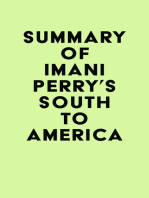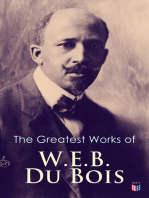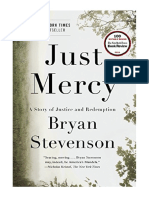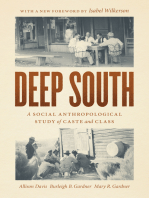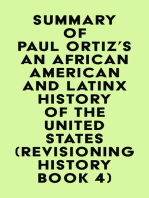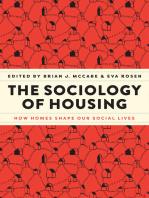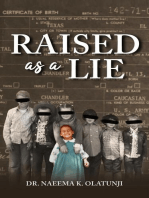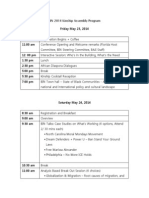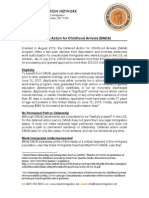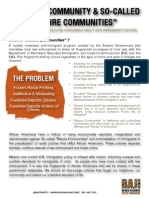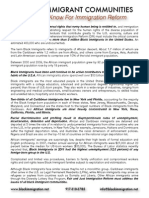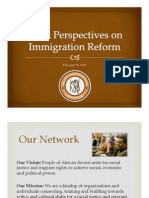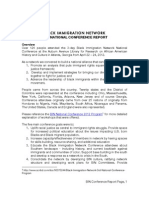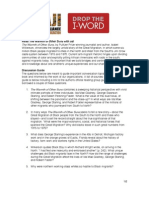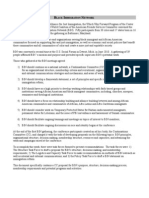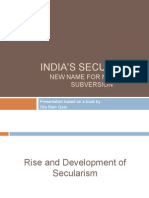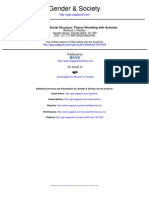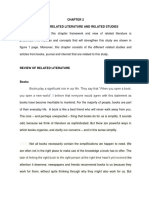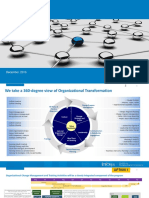Professional Documents
Culture Documents
Warmth of Other Suns Reading Guide
Uploaded by
blackimmigrationCopyright
Available Formats
Share this document
Did you find this document useful?
Is this content inappropriate?
Report this DocumentCopyright:
Available Formats
Warmth of Other Suns Reading Guide
Uploaded by
blackimmigrationCopyright:
Available Formats
Read The Warmth of Other Suns with us!
The Warmth of Other Suns, by Pulitzer Prize-winning journalist and author, Isabel Wilkerson, chronicles the largely untold story of the Great Migration, in which some six million Black people migrated to cities in the North and West from the South's Jim Crow caste system between 1915 and 1970. Current anti-migrant rhetoric hinges upon dividing communities of color and explicitly pitting African Americans with roots in the south, against migrants today. It's important that we build bridges and continue to foster respect and knowledge about one another's unique experiences and our shared history. Discussion Guide The questions below are meant to guide important conversation topics based on the book and informed by the work of our organizations. A list of sources we used for the guide is below including a link to the authors official reading group guide, from which we borrowed a couple of these questions. 1. The Warmth of Other Suns combines a sweeping historical perspective with vivid intimate portraits of three individuals: Ida Mae Gladney, George Swanson Starling, and Robert Pershing Foster. What is the value of this dual focus, of shifting between the panoramic and the close-up? In what ways are Ida Mae Gladney, George Starling, and Robert Foster representative of the millions of other migrants who journeyed from South to North? 2. In many ways The Warmth of Other Suns seeks to tell a new storyabout the Great Migration of Black people from the South to the North and those who stayedand to set the record straight about the true significance of that migration. What were the major economic, social, and historical forces that sparked the Great Migration? Why did blacks leave in such great numbers from 1915 to 1970? 3. What does George Starlings experience in the 40s in Detroit, Michigan factory work and in the orange groves of Eustis, Florida reveal about the history of factory, farm work and workers rights in the United States? 4. Wilkerson quotes Black Boy in which Richard Wright wrote, on arriving in the North: I had fled one insecurity and embraced another (p. 242). What unique challenges did Black migrants face in the North? How did the range of challenges during the Great Migration affect the lives of Ida Mae Gladney, George Starling, and Robert Foster? 5. Why were northern working-class whites so hostile to Black migrants?
1/2
6. Wilkerson points out that the three most influential figures in jazz were all children of the Great Migration: Miles Davis, Thelonious Monk, and John Coltrane. How have arts and culture in the United States been shaped by the Great Migration? 7. What were the most horrifying conditions of Jim Crow South? What instances of racial terrorism stand out most strongly in the book? What daily injustices and humiliations did Black people have to face there? 8. What is the comparison between Jim Crow racism and contemporary racism? What has changed and what hasnt? What does this mean for society? 9. What were the economic arguments leveled against migrants leaving the South from people both in the South and North? What were the challenges to the economic dignity of Black people who stayed in the South and those that left? Were the arguments against migration similar to the ones we hear now in the contemporary immigration debate? 10. How might learning this history be important for building bridges between Black communities with roots in the South and recent immigrants of all backgrounds? References We used these sources to write our guide. Look them up to learn more about the Great Migration. The Warmth of Other Suns Official Reading Group Guide http://isabelwilkerson.com/the-book/reading-group-guide/ Up South: African-American Migration in the Era of the Great War http://ashp.cuny.edu/ashp-documentaries/up-south/http://ashp.cuny.edu/ashpdocumentaries/up-south/ In Motion: The African-American Migration Experience of the Schomburg Center for Research in Black Culture http://www.inmotionaame.org/home.cfm About Us The Black Alliance for Just Immigration (BAJI) is an education and advocacy group comprised of African Americans and black immigrants from Africa, Latin America and the Caribbean. BAJI's analysis emphasizes the impact of racism and economic globalization on African American and immigrant communities as a basis for forging alliances across these communities. Visit blackalliance.org for more information. Drop the I-Word is a public education campaign presented by the Applied Research Center and Colorlines.com and powered by immigrants and diverse communities across the country that value human dignity and are working to eradicate the dehumanizing term "illegals" and related language, from everyday use and public discourse. The i-word opens the door to racial profiling and violence and prevents truthful, respectful debate on immigration. No human being is "illegal." Visit droptheiword.com for more information.
2/2
You might also like
- Climbing a Broken Ladder: Contributors of College Success for Youth in Foster CareFrom EverandClimbing a Broken Ladder: Contributors of College Success for Youth in Foster CareNo ratings yet
- A White Guy Confronting Racism: An Invitation to Reflect and ActFrom EverandA White Guy Confronting Racism: An Invitation to Reflect and ActNo ratings yet
- Summary of Hanif Abdurraqib's They Can't Kill Us Until They Kill UsFrom EverandSummary of Hanif Abdurraqib's They Can't Kill Us Until They Kill UsNo ratings yet
- Black rage (lawDocument2 pagesBlack rage (lawmisanthropo0% (2)
- Under the Skin: racism, inequality, and the health of a nationFrom EverandUnder the Skin: racism, inequality, and the health of a nationRating: 4 out of 5 stars4/5 (2)
- Miss Chloe: A Memoir of a Literary Friendship with Toni MorrisonFrom EverandMiss Chloe: A Memoir of a Literary Friendship with Toni MorrisonNo ratings yet
- The Accommodation: The Politics of Race in an American CityFrom EverandThe Accommodation: The Politics of Race in an American CityRating: 4 out of 5 stars4/5 (5)
- The Greatest Works of W.E.B. Du Bois: The Souls of Black Folk, The Suppression of the African Slave Trade, Darkwater, The Conservation of Races, The Economic Revolution in the South, Religion in the South, The Black North…From EverandThe Greatest Works of W.E.B. Du Bois: The Souls of Black Folk, The Suppression of the African Slave Trade, Darkwater, The Conservation of Races, The Economic Revolution in the South, Religion in the South, The Black North…No ratings yet
- Faces at Bottom of W 00 Bell RichDocument248 pagesFaces at Bottom of W 00 Bell RichShubho Das100% (1)
- Plantation Theory: The Black Professional's Struggle Between Freedom and SecurityFrom EverandPlantation Theory: The Black Professional's Struggle Between Freedom and SecurityNo ratings yet
- Education at War: The Fight for Students of Color in America's Public SchoolsFrom EverandEducation at War: The Fight for Students of Color in America's Public SchoolsNo ratings yet
- Required Reading For White America From A Group of Black Writers and Academics - The Boston GlobeDocument9 pagesRequired Reading For White America From A Group of Black Writers and Academics - The Boston GlobeTyler Smith100% (3)
- The Great Migration and Isabel Wilkerson Book Review: The New YorkerDocument5 pagesThe Great Migration and Isabel Wilkerson Book Review: The New YorkeridschunNo ratings yet
- The Warmth of Other Suns: The Epic Story of America's Great Migration - Isabel WilkersonDocument5 pagesThe Warmth of Other Suns: The Epic Story of America's Great Migration - Isabel Wilkersonhemegyki0% (3)
- Just Mercy: A Story of Justice and Redemption - Bryan StevensonDocument6 pagesJust Mercy: A Story of Justice and Redemption - Bryan Stevensoncylukimy0% (5)
- Deep South: A Social Anthropological Study of Caste and ClassFrom EverandDeep South: A Social Anthropological Study of Caste and ClassNo ratings yet
- ChampedDocument182 pagesChampedMelany Poppe ZamoranoNo ratings yet
- The Negro Motorist Green BookDocument43 pagesThe Negro Motorist Green BookThe_Manual100% (7)
- Black in White Space: The Enduring Impact of Color in Everyday LifeFrom EverandBlack in White Space: The Enduring Impact of Color in Everyday LifeRating: 5 out of 5 stars5/5 (2)
- Angela Davis' Revolutionary Reading List - Radical ReadsDocument4 pagesAngela Davis' Revolutionary Reading List - Radical ReadsTyler SmithNo ratings yet
- I Choose To Stay: A Black Teacher Refuses To Desert The Inner-cityFrom EverandI Choose To Stay: A Black Teacher Refuses To Desert The Inner-cityRating: 2.5 out of 5 stars2.5/5 (2)
- I Won't Shut Up: Finding Your Voice When the World Tries to Silence YouFrom EverandI Won't Shut Up: Finding Your Voice When the World Tries to Silence YouNo ratings yet
- Caste (Oprah's Book Club) : The Origins of Our Discontents - Isabel WilkersonDocument5 pagesCaste (Oprah's Book Club) : The Origins of Our Discontents - Isabel Wilkersonlucypazy50% (2)
- Summary of Paul Ortiz's An African American and Latinx History of the United States (REVISIONING HISTORY Book 4)From EverandSummary of Paul Ortiz's An African American and Latinx History of the United States (REVISIONING HISTORY Book 4)No ratings yet
- An Abolitionist's Handbook: 12 Steps to Changing Yourself and the WorldFrom EverandAn Abolitionist's Handbook: 12 Steps to Changing Yourself and the WorldRating: 4.5 out of 5 stars4.5/5 (7)
- Between The World and MeDocument4 pagesBetween The World and Medafefega14% (7)
- Top 100 Books ListDocument1 pageTop 100 Books ListmonchievaleraNo ratings yet
- Dear White Woman, Please Come Home: Hand Me Your Bias, and I'll Show You Our ConnectionFrom EverandDear White Woman, Please Come Home: Hand Me Your Bias, and I'll Show You Our ConnectionRating: 4 out of 5 stars4/5 (1)
- The Sociology of Housing: How Homes Shape Our Social LivesFrom EverandThe Sociology of Housing: How Homes Shape Our Social LivesBrian J. McCabeNo ratings yet
- Summary of Harlem Shuffle: by Colson Whitehead - A Comprehensive SummaryFrom EverandSummary of Harlem Shuffle: by Colson Whitehead - A Comprehensive SummaryRating: 4 out of 5 stars4/5 (1)
- Workbook for The Sum of Us: What Racism Costs Everyone and How We Can Prosper Together by Heather McGhee (Max Help Workbooks)From EverandWorkbook for The Sum of Us: What Racism Costs Everyone and How We Can Prosper Together by Heather McGhee (Max Help Workbooks)No ratings yet
- Saving Our Sons: Raising Black Children in a Turbulent WorldFrom EverandSaving Our Sons: Raising Black Children in a Turbulent WorldRating: 4 out of 5 stars4/5 (3)
- To Live More Abundantly: Black Collegiate Women, Howard University, and the Audacity of Dean Lucy Diggs SloweFrom EverandTo Live More Abundantly: Black Collegiate Women, Howard University, and the Audacity of Dean Lucy Diggs SloweNo ratings yet
- Just Mercy A Story of Justice and RedemptionDocument3 pagesJust Mercy A Story of Justice and Redemptionhusny perketansan0% (1)
- The Case For Reparations EssayDocument2 pagesThe Case For Reparations Essaydiogopires_9550% (2)
- Summary of Isabel Wilkerson's The Warmth of Other SunsFrom EverandSummary of Isabel Wilkerson's The Warmth of Other SunsRating: 5 out of 5 stars5/5 (1)
- There There by Tommy OrangeDocument5 pagesThere There by Tommy Orangezidijoca30% (20)
- Between the World and Me: by Ta-Nehisi Coates | Conversation StartersFrom EverandBetween the World and Me: by Ta-Nehisi Coates | Conversation StartersRating: 1 out of 5 stars1/5 (1)
- We Were Eight Years in Power: by Ta-Nehisi Coates | Conversation StartersFrom EverandWe Were Eight Years in Power: by Ta-Nehisi Coates | Conversation StartersNo ratings yet
- Racial Myths in Medicine from Slavery to TodayDocument4 pagesRacial Myths in Medicine from Slavery to TodayManuel Kevogo0% (1)
- Appalachian ElegyDocument97 pagesAppalachian ElegyRose Oliveira67% (3)
- To You We Shall Return: Lessons About Our Planet from the LakotaFrom EverandTo You We Shall Return: Lessons About Our Planet from the LakotaRating: 4 out of 5 stars4/5 (1)
- Matthew Desmond’s EVICTED: Poverty and Profit in the American City | SummaryFrom EverandMatthew Desmond’s EVICTED: Poverty and Profit in the American City | SummaryRating: 5 out of 5 stars5/5 (3)
- African Immigrants in CaliforniaDocument1 pageAfrican Immigrants in CaliforniablackimmigrationNo ratings yet
- BIN Policy Brief: Immigration ActionDocument4 pagesBIN Policy Brief: Immigration ActionblackimmigrationNo ratings yet
- BIN Principles For Administrative Relief For Black Immigrant CommunitiesDocument2 pagesBIN Principles For Administrative Relief For Black Immigrant CommunitiesblackimmigrationNo ratings yet
- BIN Memo 2014 Administrative ReliefDocument3 pagesBIN Memo 2014 Administrative ReliefblackimmigrationNo ratings yet
- Diversity Visa Fact SheetDocument1 pageDiversity Visa Fact SheetblackimmigrationNo ratings yet
- BIN Kinship Assembly Official ProgramDocument14 pagesBIN Kinship Assembly Official ProgramblackimmigrationNo ratings yet
- 2014 Kinship Assembly ScheduleDocument3 pages2014 Kinship Assembly ScheduleblackimmigrationNo ratings yet
- BIN DACA RecommendationsDocument2 pagesBIN DACA RecommendationsblackimmigrationNo ratings yet
- S Comm Black BAJI FlyerDocument1 pageS Comm Black BAJI FlyerblackimmigrationNo ratings yet
- FAQs Blacks in The US and ImmigrantsDocument1 pageFAQs Blacks in The US and ImmigrantsblackimmigrationNo ratings yet
- An Open Letter To The Senate Judiciary Committee Ten Demands For Fair and Just Immigration ReformDocument3 pagesAn Open Letter To The Senate Judiciary Committee Ten Demands For Fair and Just Immigration ReformblackimmigrationNo ratings yet
- Achieving Racial Justice in Immigration ReformDocument7 pagesAchieving Racial Justice in Immigration ReformblackimmigrationNo ratings yet
- Understanding Mass Incarceration and Mass DetentionDocument4 pagesUnderstanding Mass Incarceration and Mass DetentionblackimmigrationNo ratings yet
- May 13 SJC Amend CIR Sign On LetterDocument3 pagesMay 13 SJC Amend CIR Sign On LetterblackimmigrationNo ratings yet
- Black Immigrant Fact SheetDocument1 pageBlack Immigrant Fact SheetblackimmigrationNo ratings yet
- BIN Webinar Slides PDFDocument40 pagesBIN Webinar Slides PDFblackimmigrationNo ratings yet
- Black Immigration Network 2012 Conference SummaryDocument12 pagesBlack Immigration Network 2012 Conference SummaryblackimmigrationNo ratings yet
- BIN's Principles For Just Immigration ReformDocument1 pageBIN's Principles For Just Immigration ReformblackimmigrationNo ratings yet
- BIN National Steering Committee FormDocument1 pageBIN National Steering Committee FormblackimmigrationNo ratings yet
- Warmth of Other Suns Reading GuideDocument2 pagesWarmth of Other Suns Reading Guideblackimmigration100% (2)
- Crossing Boundaries, Connecting Communities: Alliance Building For Immigrant Rights and Racial Justice.Document74 pagesCrossing Boundaries, Connecting Communities: Alliance Building For Immigrant Rights and Racial Justice.blackimmigration100% (1)
- Black Immigration Network 3rd National Conference ProgramDocument16 pagesBlack Immigration Network 3rd National Conference ProgramblackimmigrationNo ratings yet
- BAJI Reader Spring 2009Document49 pagesBAJI Reader Spring 2009blackimmigrationNo ratings yet
- BAJI Reader Spring 2011Document28 pagesBAJI Reader Spring 2011blackimmigration100% (1)
- BIN Document Revised 3.4.11Document6 pagesBIN Document Revised 3.4.11blackimmigrationNo ratings yet
- Black Voices Call For New Approaches To Immigration ReformDocument4 pagesBlack Voices Call For New Approaches To Immigration Reformblackimmigration100% (1)
- Support For Haitian Families: A Statement of The Black Alliance For Just ImmigrationDocument4 pagesSupport For Haitian Families: A Statement of The Black Alliance For Just ImmigrationblackimmigrationNo ratings yet
- On Some Recent Translations of The Qur'ān PDFDocument8 pagesOn Some Recent Translations of The Qur'ān PDFscaricascaricaNo ratings yet
- India's Secularism New Name For National SubversionDocument64 pagesIndia's Secularism New Name For National SubversionBharat KrishnaNo ratings yet
- Franklin Et Al. - 2000 - Global Nature, GlobalDocument129 pagesFranklin Et Al. - 2000 - Global Nature, Globalalparslan nasNo ratings yet
- Pornography and Hate Speech NotesDocument3 pagesPornography and Hate Speech NotesCharlie St. CloudNo ratings yet
- IHRM in USA: Business Environment and Cultural IssuesDocument9 pagesIHRM in USA: Business Environment and Cultural IssuesjayNo ratings yet
- Y1 Transit RecordDocument41 pagesY1 Transit RecordJanet YauNo ratings yet
- Gender and Society-SageDocument23 pagesGender and Society-SagetentendcNo ratings yet
- Report of Work Done Jaydeep Mehta August 2016Document1 pageReport of Work Done Jaydeep Mehta August 2016api-193311681No ratings yet
- Muhamad Ramdhani - PSYCHOLINGUISTICS - Individual Assignment 1Document5 pagesMuhamad Ramdhani - PSYCHOLINGUISTICS - Individual Assignment 1Muhamad RamdhaniNo ratings yet
- Effect Design On Store ImageDocument13 pagesEffect Design On Store Imagebermand75No ratings yet
- Rizal Poems Interpretation From InternetDocument7 pagesRizal Poems Interpretation From InternetJan Myckel PerezNo ratings yet
- Emceeing Toughness Toughing Up The Emcee PDFDocument23 pagesEmceeing Toughness Toughing Up The Emcee PDFQuentin Emmanuel WilliamsNo ratings yet
- ABYIPDocument18 pagesABYIP千住 マリエルNo ratings yet
- Schneider2008 PDFDocument25 pagesSchneider2008 PDFPedro ArayaNo ratings yet
- TVL Home Economics Lesson Plan Cleaning ScheduleDocument3 pagesTVL Home Economics Lesson Plan Cleaning ScheduledarlenecabridoNo ratings yet
- Mapeh 10 ReviewerDocument1 pageMapeh 10 ReviewerLeslie Ann SolisNo ratings yet
- Review of Related Literature and Related Studies in The Chapter This Chapter Framework and View of Related Literature IsDocument5 pagesReview of Related Literature and Related Studies in The Chapter This Chapter Framework and View of Related Literature IsAdrian IntrinaNo ratings yet
- Design Theory Article - Final Article - Thov ReimeDocument12 pagesDesign Theory Article - Final Article - Thov ReimeZota AndreiNo ratings yet
- CapistranoAlexandria PDFDocument3 pagesCapistranoAlexandria PDFAlexandriaNo ratings yet
- Every Human Being Who Reaches The Age of Understanding of The Purpose of MoneyDocument3 pagesEvery Human Being Who Reaches The Age of Understanding of The Purpose of MoneyjoryekaNo ratings yet
- 4 Sacred Animals in VietnamDocument2 pages4 Sacred Animals in VietnamTu NguyenNo ratings yet
- IslamDocument16 pagesIslamJuliana PenadoNo ratings yet
- Project Reports Restaurant BusinessDocument10 pagesProject Reports Restaurant BusinessraviNo ratings yet
- Schools Division Office of Pampanga Dampe Elementary SchoolDocument11 pagesSchools Division Office of Pampanga Dampe Elementary SchoolrolandNo ratings yet
- Oral Defense Powerpoint LayoutDocument2 pagesOral Defense Powerpoint LayoutGlenn GalvezNo ratings yet
- A10EL-Ib-1 A10EL-Ia-2 A10EL-Ia-3: Have The Class Answers TheDocument2 pagesA10EL-Ib-1 A10EL-Ia-2 A10EL-Ia-3: Have The Class Answers TheJoshua GuiriñaNo ratings yet
- Org Change MGMT Example Proposal - 20161206Document17 pagesOrg Change MGMT Example Proposal - 20161206Candice H.No ratings yet
- Role of Tech & Media in EducationDocument2 pagesRole of Tech & Media in EducationOhdy Ronquillo - RoselloNo ratings yet
- Part II LESSON 4 Spiritual SelfDocument38 pagesPart II LESSON 4 Spiritual SelfMelvin Pogi138No ratings yet
- KUK entrance exam centresDocument1 pageKUK entrance exam centresAjay ChoudharyNo ratings yet










